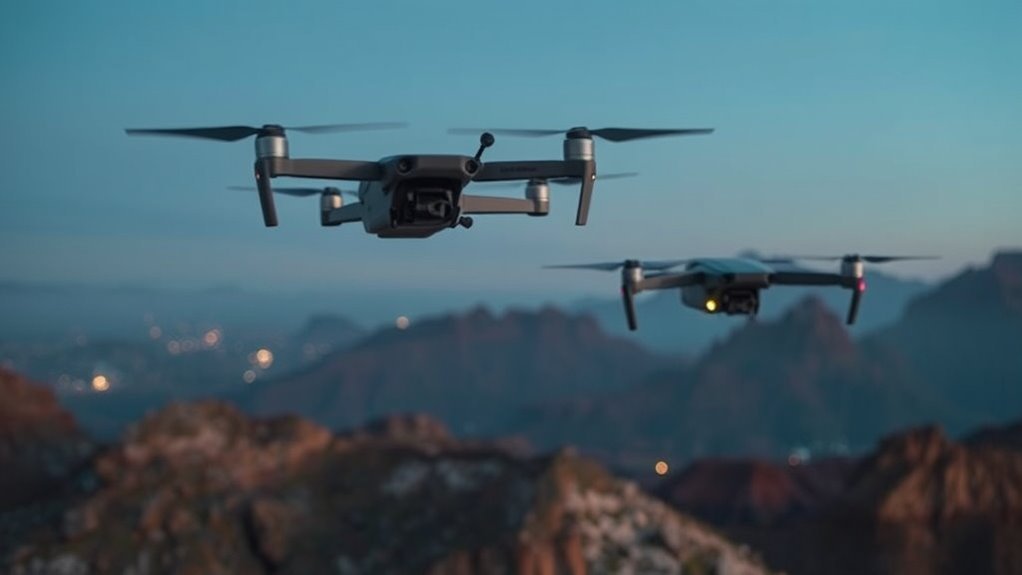When you’re comparing the Asylon DroneCore and DJI Mavic 3 Thermal, you’ll find Asylon’s 7km LTE transmission pairs with superior thermal sensitivity (under 40mK NETD) for detailed heat detection, while DJI’s 15km O3+ offers longer range and low latency with 50mK accuracy. Both boast strong security like AES-256, but Asylon’s modular design edges out for field reliability. Further exploration highlights key operational differences.
Thermal Imaging Capabilities
When comparing the thermal imaging capabilities of the Asylon DroneCore and DJI Mavic 3 Thermal, two key factors stand out: sensor resolution and thermal sensitivity. You’ll find the Asylon DroneCore’s infrared resolution reaches up to 640×512 pixels, offering you sharper thermal details for precise monitoring in open environments. In contrast, the DJI Mavic 3 Thermal’s 640×512 infrared resolution matches this, but it’s optimized for compact operations, giving you flexibility in constrained spaces.
Regarding temperature sensitivity, the Asylon DroneCore boasts a lower NETD of under 40mK, allowing you to detect subtle heat variations with greater accuracy, empowering your independent surveillance efforts. The DJI Mavic 3 Thermal, with its 50mK temperature sensitivity, performs well but may miss finer nuances, potentially limiting your freedom in critical scenarios.
Additionally, the Asylon DroneCore’s advanced sensors and AI algorithms can enhance your real-time monitoring capabilities, ensuring you have the most responsive thermal insights available. Ultimately, you’re choosing between the DroneCore’s superior sensitivity for unchained thermal insights and the Mavic’s balanced approach, based on your need for unfettered control. (148 words)
Transmission Technologies Comparison
Key differences in transmission technologies between the Asylon DroneCore and DJI Mavic 3 Thermal include range, latency, and security protocols. As you compare these systems, you’ll see how Asylon’s LTE-based setup emphasizes transmission distance for expansive, unobstructed operations, while DJI’s O3+ technology boosts signal stability in varied environments, empowering you to maintain control without interruptions.
| Aspect | Asylon DroneCore | DJI Mavic 3 Thermal |
|---|---|---|
| Transmission Distance | Up to 7km via LTE | Up to 15km via O3+ |
| Signal Stability | High in open areas with cellular | Excellent in line-of-sight |
| Latency | Moderate (under 200ms) | Low (around 120ms) |
| Security Protocols | Advanced encryption for secure links | AES-256 for data protection |
| Overall Reliability | Cellular-dependent stability | RF-focused for freedom in remote ops |
You can leverage these differences to select a drone that aligns with your need for unfettered aerial exploration, ensuring peak performance in your chosen scenarios.
Ease of Use and Reliability
Ease of use and reliability in the Asylon DroneCore and DJI Mavic 3 Thermal hinge on their design choices, with Asylon prioritizing modular setups for straightforward field maintenance, while DJI’s refined app integration guarantees seamless operation even in challenging scenarios. You’ll appreciate Asylon’s user friendly interface, which lets you swap components on the fly, fostering operational consistency for independent missions in unrestricted environments. This modular approach minimizes downtime, giving you the freedom to adapt without relying on complex tools. On the other hand, DJI’s system excels in its intuitive controls and robust app, ensuring you’re always connected with high operational consistency during extended flights. When comparing both, Asylon suits users seeking customizable reliability for off-grid freedom, whereas DJI delivers polished dependability for scenarios demanding quick, hassle-free control. Ultimately, your choice depends on valuing modularity’s autonomy versus app-driven precision.
Frequently Asked Questions
How Much Does Asylon Dronecore Cost?
You’re asking about Asylon DroneCore’s cost, which varies based on Asylon pricing models. It’s priced from around $5,000 to $15,000, depending on configurations that enhance DroneCore features like advanced LTE connectivity and thermal imaging for secure operations. Compared to competitors, you’ll find it offers greater freedom in long-range missions, ensuring you’re not tied to proprietary systems, empowering your independent aerial surveillance.
What Is the Battery Life of DJI Mavic 3 Thermal?
You’re wondering about the DJI Mavic 3 Thermal’s battery life, which showcases impressive battery performance for its class. It’s rated for up to 46 minutes of flight time under ideal conditions, enabling you to leverage its advanced thermal capabilities fully. This endurance lets you conduct secure, independent thermal inspections without constant recharges, giving you the freedom to operate extensively compared to models with shorter battery spans.
Are These Drones Legal for Commercial Use?
You’re wondering if drones are legal for commercial use, and it depends on your location’s commercial regulations and drone licensing requirements. In the US, you’ll need FAA Part 107 certification, which objectively compares to other nations’ stricter rules, offering you more operational freedom once obtained. Always check local laws to guarantee compliance, as these vary; for instance, Europe’s EASA demands additional permits, balancing security with your autonomy. This approach lets you navigate restrictions effectively for commercial endeavors.
What Accessories Are Available for Purchase?
You’ll discover that over 70% of drone users enhance their setups with accessories, boosting performance considerably. When you’re exploring accessory options for your drone, especially those integrating thermal imaging, you’ll compare extended battery packs for longer flights, rugged carrying cases, and specialized thermal lenses offering up to 640×512 resolution. These empower your aerial freedom, ensuring objective, tech-driven choices for secure operations.
Do These Drones Include a Warranty?
When you’re wondering if these drones include a warranty, you’ll find that warranty details vary. For the Asylon DroneCore, it typically offers a 1-year warranty with strong customer support, ensuring your operational freedom through reliable repairs. In comparison, the DJI Mavic 3 Thermal provides a similar 1-year coverage, but Asylon’s might edge out with more responsive assistance for uninterrupted autonomy. Always check official sites for specifics.

